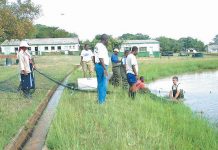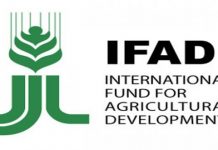[ad_1]
Funded by the Japanese International Cooperation Agency (JICA) and co-organized with the Ministry of Fisheries (MoF), the Biosecurity Agency of Fiji (BAF), the University of South Pacific (USP) and facilitated by FAO, the workshop participated by 39 representing the government, the academe (USP), producers (Pacific Ocean Culture Pte Ltd., The Crab Company of Fiji Ltd., Valili Pearls Co., Ltd., Pacific Ocean Culture Pte Ltd., Aquarium Fish (Fiji) Ltd. and Vet Essentials Fiji Ltd.) and regional and international organizations (FAO, JICA, Secretariat of the Pacific Community), prepared a draft NAAHB Strategy. A broad yet comprehensive strategy for building and enhancing capacity for the management of national aquatic biosecurity and aquatic animal health, the strategy will focus on five priority commodities, namely: prawn & shrimp, seaweeds, pearls, Nile tilapia, giant clam & sandfish. The strategy contains the national action plans at the short-, medium- and long-term using phased implementation based on national needs and priorities. The strategy framework consists of Purpose and Vision Statements and Guiding Principles. The strategy includes 10 Programme Component/Elements, each one contains a description of the scope, objectives, current status and projects/activities that will be implemented at the short-, medium- and long-term based on national needs and priorities. Responsible entities for each project/activity are also included as well as an Implementation Plan. The 10 Programme Components/Elements are: (1) Policy, Legislation and Enforcement, (2) Risk Analysis, (3) Pathogen List, (4) Border Inspection and Quarantine, (5) Surveillance, Monitoring and Reporting, (6) Emergency Preparedness and Contingency Planning, (7) Institutional Structure (Including Infrastructure), (8) Research and Development, (9) Regional and International Cooperation, and (10) Capacity Building.
Development of a NAAHB Strategy involves an extensive & iterative process led by the Competent Authority and extensive consultation with key stakeholders from other government agencies, academia and the private sector. It is a proactive measure without which a country can only react in a piecemeal fashion to new developments in international trade and the global situation with regard to serious transboundary aquatic animal diseases (TAADs), and its aquaculture and fisheries sectors will remain highly vulnerable to new and emerging diseases that may severely affect capture fisheries and aquaculture production, leading to major social and economic impacts.
Fiji can take an important lead role in setting an example for the Pacific region with a vision that Fiji’s aquatic wildlife and aquaculture species thrive in a healthy environment, valued by its society that embraces and sustainably benefits from the diversity of its aquatic resources.
Fiji’s MoF has taken the initial necessary steps for developing a NAAHB Strategy for the country. The development of this strategy is a very timely initiative and is in line and in parallel to a number of legal and policy instruments (e.g. Aquaculture Bill 2016 scheduled for 3rd hearing at the Parliament; the draft National Fisheries Policy and the draft Fiji Aquaculture Strategy) – all of which will support sustainable aquaculture development.
Mr Semi Koroilavesau, The Honorable Minister for Fisheries, Mr Hiroyuki Sawada, JICA Resident Representative, Dr Ciro Rico, Head of the School of Marine Studies of USP, Dr Robin Yarrow, Keynote Speaker and Chairperson of National Trust of Fiji and Dr Melba Reantaso of FAO graced the Opening session of the workshop.
Further information can be obtained by writing to Melba.Reantaso@fao.org
[ad_2]
Source link




